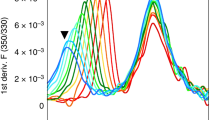Abstract
MAJOR histocompatibility complex (MHC) class I molecules present antigen by transporting peptides from intracellularly degraded proteins to the cell surface for scrutiny by cytotoxic T cells. Recent work suggests that peptide binding may be required for efficient assembly and intracellular transport of MHC class I molecules1, but it is not clear whether class I molecules can ever assemble in the absence of peptide. We report here that culture of the murine lymphoma mutant cell line RMA-S at reduced temperature (19–33 °C) promotes assembly, and results in a high level of cell surface expression of H-2/β2-microglobulin complexes that do not present endogenous antigens, and are labile at 37 °C. They can be stabilized at 37 °C by exposure to specific peptides known to interact with H–2Kb or Db. Our findings suggest that, in the absence of peptides, class I molecules can assemble but are unstable at body temperature. The induction of such molecules at reduced temperature opens new ways to analyse the nature of MHC class I peptide interactions at the cell surface.
Similar content being viewed by others
References
Townsend, A. et al. Nature 340, 443–448 (1989).
Ljunggren, H. G. & Kärre, K. J. exp. Med. 142, 1745–1759 (1985).
Kärre, K., Ljunggren, H. G., Piontek, G. & Kiessling, R. Nature 319, 675–678 (1986).
Ōhlén, C. et al. J. Immun. (in the press).
Ōhlén, C. et al. Eur. J. Immun. (in the press).
Lippincott-Schwartz, J., Bonifacino, J. S., Yuan, L. C. & Klausner, R. D. Cell 54, 209–220 (1988).
Yewdell, J. W. & Bennink, J. R. Science 244, 1072–1075 (1989).
Nuchtern, J. G., Bonifacino, J. S., Biddison, W. E. & Klausner, R. D. Nature 339, 223–226 (1989).
Schumacher, T. N. M. et al. Cell (in the press).
Townsend, A. R. M. et al. Cell (in the press).
Lechler, R. I., Lombardi, G., Batchelor, J. R., Reinsmoen, N. & Bach, F. G. Immun. Today 11, 83–88 (1990).
Severinson, L., Martens, I. & Peterson, P. A. J. Immun. 137, 1003–1009 (1986).
Ljunggren, H. G. & Kärre, K. Immun. Today 11, 237–244 (1990).
Neefjes, J. J., Stollorz, V., Peters, P. J., Geuze, H. J. & Ploegh, H. L. Cell 61, 171–183 (1990).
Lögdberg, L., Ōstergren, P. O. & Peterson, P. A. Molec. Immun. 14, 577–587 (1979).
Kvist, S., Östberg, L. & Peterson, P. A. Scand. J. Immun. 7, 265–276 (1978).
Neefjes, J. J., Breur-Vriesendorp, B. S., van Seventer, G. A., Ivanyi, P. & Ploegh, H. L. Human Immun. 14, 149–181 (1986).
Philips, D. R. & Morrison, M. Biochem. biophys. Res. Commun. 40, 284–289 (1970).
Ozato, K. & Sachs, D. H. J. Immun. 126, 317–321 (1981).
Ozato, K., Hansen, T. H. & Sachs, D. H. J. Immun. 125, 2473–2477 (1980).
Allen, H., Wraith, D., Pala, P., Askonas, B. & Flavell, R. A. Nature 309, 279–281 (1984).
Allen, H., Fraser, J., Flyer, D., Calvin, S. & Flavell, R. Proc. natn. Acad. Sci. U.S.A. 83, 7447–7451 (1986).
Hämmerling, G. J., Hämmerling, U. & Lemke, H. Immunogenetics 8, 433–445 (1979).
Townsend, A. R. M., Gotch, F. M. & Davey, J. Cell 42, 457–467 (1985).
Jones, B. & Janeway, C. A. Nature 292, 547–549 (1981).
Tada, N. et al. Immunogenetics 11, 441–444 (1980).
Chorney, M., Sehn, F. W., Michaelson, J. & Boyse, E. A. Immunogenetics 14, 91–93 (1982).
Townsend, A. R. M. et al. J. exp. Med. 148, 1211–1224 (1988).
Townsend, A. R. M. et al. Cell 44, 959–968 (1986).
Bodmer, H. C., Bastin, J. M., Askonas, B. A. & Townsend, A. R. M. Immunology 66, 143–149 (1989).
Author information
Authors and Affiliations
Rights and permissions
About this article
Cite this article
Ljunggren, HG., Stam, N., Öhlén, C. et al. Empty MHC class I molecules come out in the cold. Nature 346, 476–480 (1990). https://doi.org/10.1038/346476a0
Received:
Accepted:
Issue Date:
DOI: https://doi.org/10.1038/346476a0
- Springer Nature Limited
This article is cited by
-
Cryptic MHC-E epitope from influenza elicits a potent cytolytic T cell response
Nature Immunology (2023)
-
Machinery that guides immunity
Nature (2017)
-
Bystander cells enhance NK cytotoxic efficiency by reducing search time
Scientific Reports (2017)
-
Immune selection during tumor checkpoint inhibition therapy paves way for NK-cell “missing self” recognition
Immunogenetics (2017)
-
The role of MHC class Ib-restricted T cells during infection
Immunogenetics (2016)





